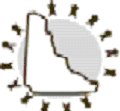Government of Yukon
Archives

![]()

FOR RELEASE #05-137
May 19, 2005
New Regime To Manage Yukon Placer Mining Developed Through Cooperation
Dawson City, Yukon - A new, integrated framework to manage Yukon placer mining that was developed in cooperation by three levels of government was announced today by Archie Lang, Yukon Minister of Energy, Mines and Resources; Eric Morris, Grand Chief of the Council of Yukon First Nations; and MP Larry Bagnell, representing Geoff Regan, federal Minister of Fisheries and Oceans.
The new regime is the result of a unique process, in which the Yukon, First Nations and Canadian governments agreed in May 2003 to develop a regime that would "recognize the importance of a sustainable placer industry to the Yukon and the importance of conservation of fish and fish habitat supporting fisheries."
"We have achieved our goal to establish a process that is fair and understandable and that will provide certainty for the placer mining industry," said Minister Archie Lang. "Now that the building blocks for a new system are in place, our next step is to develop it further by establishing a Secretariat that will conduct meaningful consultations."
"This new regime addresses the interests of placer miners and the needs of fish," said Larry Bagnell, MP for the Yukon. "Central to the regime are clearly defined standards and performance targets based on science. These will be regularly reviewed and modified, as necessary, to incorporate scientific and technological advances."
"The Chiefs of the Council of Yukon First Nations endorse this new framework," Grand Chief Eric Morris said. "It is very signficant that these new rules will incorporate Traditional Knowledge, and the input from all First Nations through thorough and meaningful consultations."
The Klondike Placer Miners' Association (KPMA) is also supportive of the new regime. "We appreciate that all parties recognized each others' interests in order to ensure the rules are achievable," KPMA president Mike McDougall said.
The new framework will guide the development of individual watershed authorizations, and these will replace the Yukon Placer Authorization that has managed placer mining. The new regime combines a risk-based approach for regulatory decisions, careful monitoring of aquatic health, adaptive management and strong compliance and enforcement.
Clear, pre-determined standards will provide better protection of fish and fish habitat and greater certainty for placer miners in planning and conducting their operations.
A Secretariat that acts as an interagency coordinating committee will further develop and implement the regime and ensure it is monitored and improved. The Secretariat, which is planned to be in place for September 2005, will also provide a single regulatory window to avoid overlap, duplication and inconsistency.
First Nations, advisory boards, conservation groups, placer miners and communities will be involved in further consultations about the regime framework. The first task of the Secretariat will be to set up a schedule for consultations in the fall. Consultations will include the incorporation of traditional and local knowledge in the development of individual watershed authorizations and the design of a monitoring strategy.
Attached: Backgrounder
-30-
| For information: | |
| Bonnie King | Carrie Mishima |
| Energy, Mines and Resources | Fisheries and Oceans Canada |
| Yukon Government | Pacific Region |
| (867) 667-5307 | (604) 666-0392 |
| bonnie.king@gov.yk.ca | mishimaC@pac.dfo-mpo.gc.ca |
BACKGROUNDER: NEW PLACER REGIME
The regime:
• A process that is fair, understandable and provides certainty for miners
• Recognizes multiple objectives
• Is consistent with existing federal fish habitat policy and new Wild Salmon Policy and with the Yukon's environmental and socio-economic assessment process
• Is based on science and will incorporate traditional knowledge
• Recognizes the special realities and challenges of the Yukon
A new approach:
• Achieves better cooperative management between YTG, DFO and First Nations
• Allows more timely and transparent decisions
• Is integrated with existing Yukon licensing processes
Goals:
• To recognize the importance of a sustainable placer industry and the importance of fish and fish habitat conservation
• To consult and share information with interested parties
• To transition to new regime by 2007
Key elements:
• Fish Habitat Risk Management Decision Framework
• Individual watershed authorizations
• Environmental and socio-economic assessments
• Monitoring and adaptive management
• Streamlined, single-window approach through licensing
• Compliance, monitoring and enforcement
Key objectives:
• Monitor health of watersheds and instream water quality
• Monitor status, performance and compliance of industry
• Test criteria used to develop regime
• Adjust and refine regime as required (adaptive management)
What is Adaptive Management?
Allows conservation and habitat protection measures to be adjusted, as required, over time:
• Measure the effectiveness of the regime in achieving "no net loss" of habitat
• Propose alternative measures as needed
• Address unforeseen circumstances or changes
What is a watershed authorization?
It is an authorization issued by DFO for the "harmful alteration, disruption or destruction" of fish habitat. Unlike the Yukon Placer Authorization, where there is a single class authorization for all streams and all placer mining activities, the new approach will use one watershed authorization for each of the 19 designated watersheds in the territory. Each watershed authorization will contain the habitat regulatory requirements for all miners operating in that watershed. The requirements are based on habitat type and the severity of impact or risk for sediment discharges from settling ponds, channel diversions, water acquisition and instream works.
Role of Secretariat:
• A cooperative, administrative arrangement to assist governments in carrying out responsibilities under federal and territorial legislation
• Advisory role to governments
• Develops (through consultation), recommends and implements watershed authorizations
Implementation:
• Establish a Secretariat in September 2005
• Initiate development of watershed authorizations in November 2005
• Recommend first authorizations in Spring 2006
• Transition to new regime by 2007
